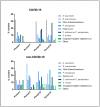Comparing the Occurrence of Healthcare-Associated Infections in Patients with and without COVID-19 Hospitalized during the Pandemic: A 16-Month Retrospective Cohort Study in a Hospital Intensive Care Unit
- PMID: 35268538
- PMCID: PMC8910983
- DOI: 10.3390/jcm11051446
Comparing the Occurrence of Healthcare-Associated Infections in Patients with and without COVID-19 Hospitalized during the Pandemic: A 16-Month Retrospective Cohort Study in a Hospital Intensive Care Unit
Abstract
The COVID-19 pandemic has increased the healthcare-associated infection (HAI) risk in intensive care unit (ICU) patients. However, a comparison between patients with and without COVID-19 in terms of HAI incidence has been rarely explored. In this study, we characterized the occurrence of HAI among patients with and without COVID-19 admitted to the ICU of the Umberto I hospital of Rome during the first 16 months of the pandemic and also identified risk factors for HAI acquisition. Patients were divided into four groups according to their ICU admission date. A multivariable conditional risk set regression model for multiple events was constructed for each admission period. Adjusted hazard ratios and 95% confidence intervals were calculated. Overall, 352 COVID-19 and 130 non-COVID-19 patients were included, and a total of 361 HAIs were recorded. We found small differences between patients with and without COVID-19 in the occurrence and type of HAI, but the infections in the two cohorts mostly involved different microorganisms. The results indicate that patient management was likely an important factor influencing the HAI occurrence during the pandemic. Effective prevention and control strategies to reduce HAI rates should be implemented.
Keywords: COVID-19; COVID-19 pandemic; SARS-CoV-2; devices-related infection; healthcare-associated infection; intensive care unit.
Conflict of interest statement
The authors declare no conflict of interest.
Figures



References
-
- European Centre for Disease Prevention and Control . Guidance for Health System Contingency Planning during Widespread Transmission of SARS-CoV-2 with High Impact on Healthcare Services. ECDC; Stockholm, Sweden: 2020.
-
- World Health Organization (WHO) Strenghtening the Health System Response to COVID-19. Maintaining the Delivery of Essential Health Care Services While Mobilizing the Health Workforce for the COVID-19 Response. World Health Organization, Regional Office for Europe; Copenhagen, Denmark: 2020.
-
- Rana S., Hughes L.A., Rana S., Adam L.A. The Effects of ICU Crisis Reorganization on Outcomes in Patients Not Infected with Coronavirus Disease 2019 During the Initial Surge of the Coronavirus Disease 2019 Pandemic. Crit. Care Explor. 2021;3:e0333. doi: 10.1097/CCE.0000000000000333. - DOI - PMC - PubMed
LinkOut - more resources
Full Text Sources
Miscellaneous

